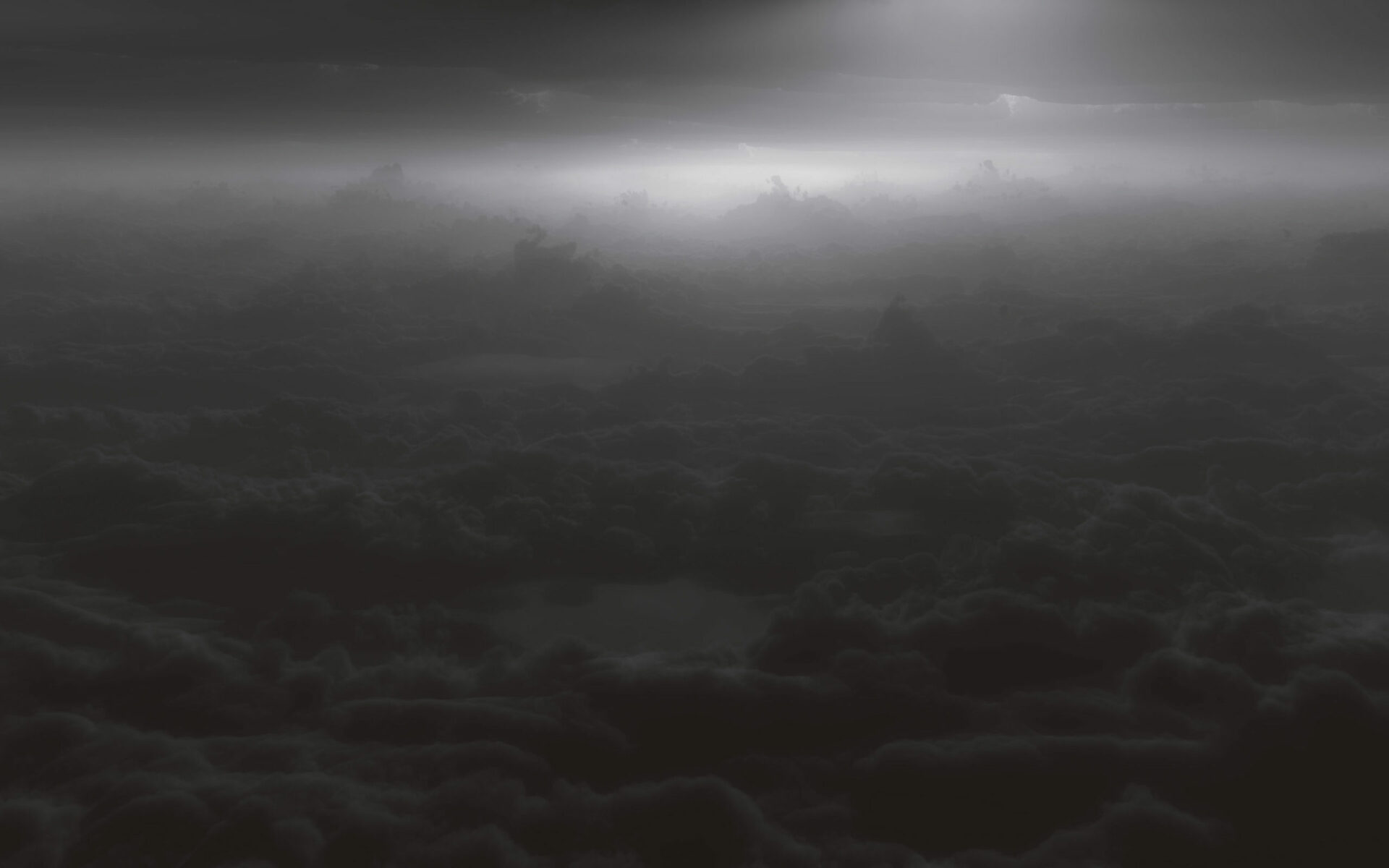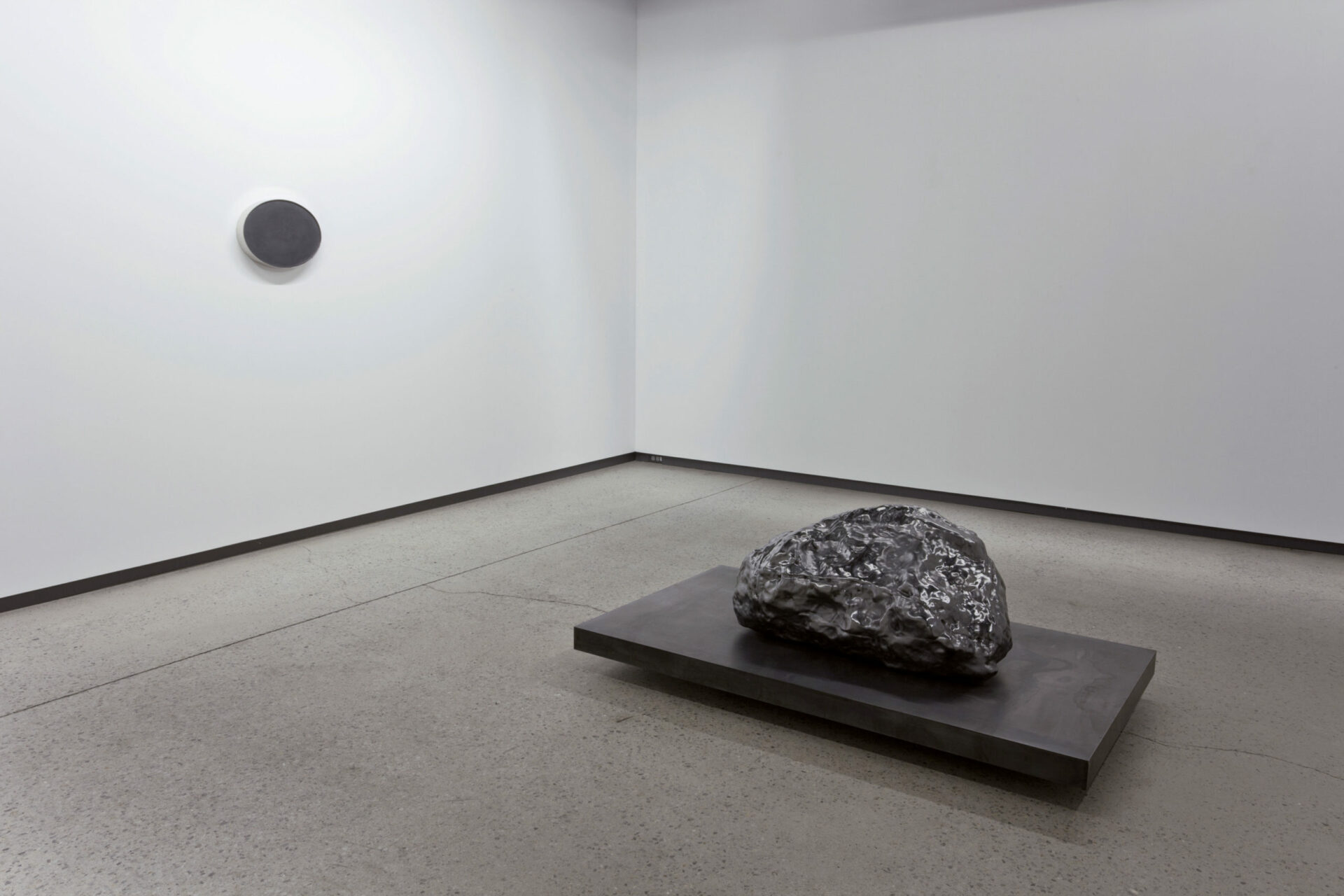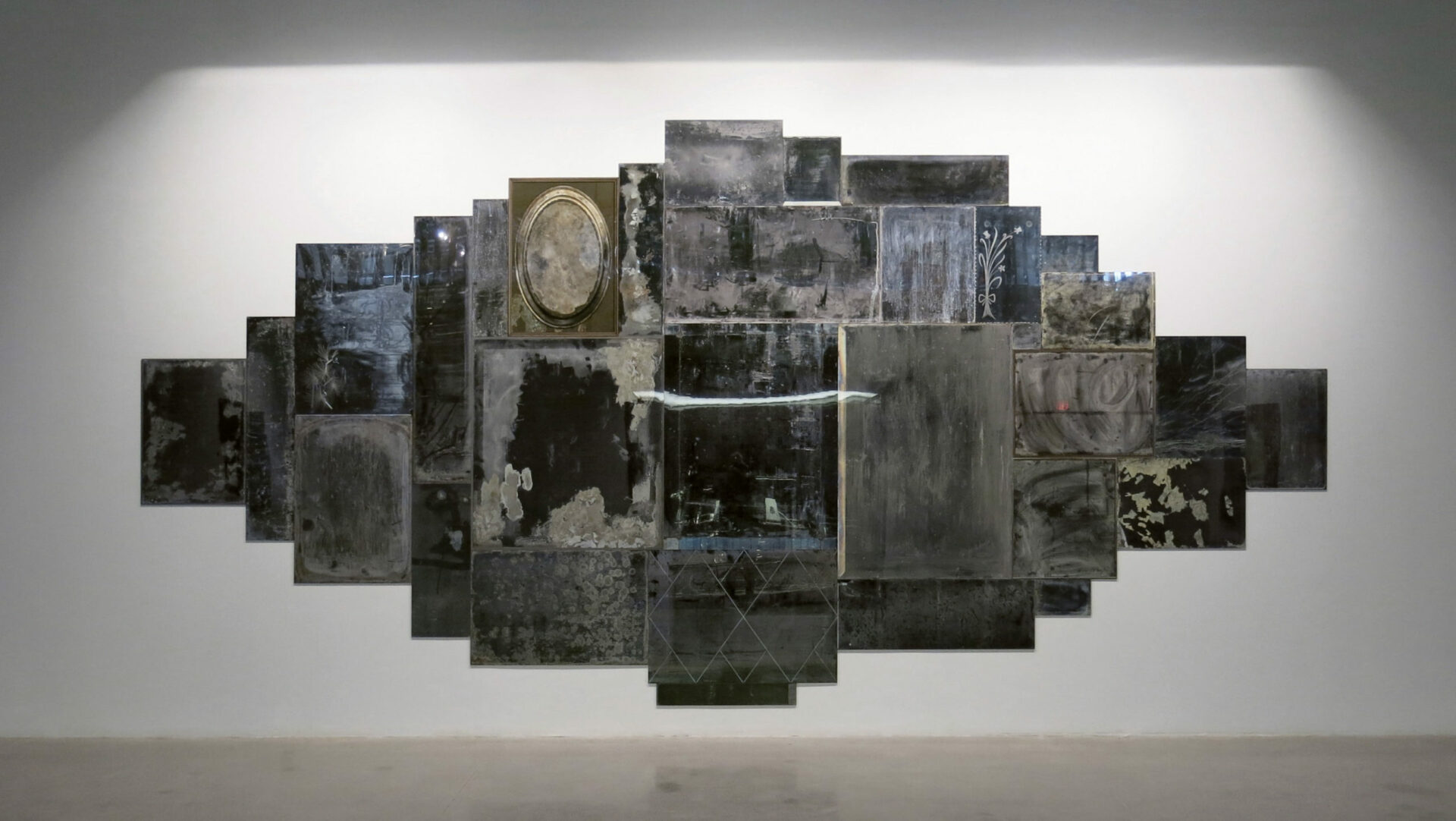
Photo : © Nicolas Baier, permission de | courtesy of Galerie Division, Montréal & Toronto
“The man who meditates not, lives in blindness; the man who
— Victor Hugo, William Shakespeare1 1 - VICTOR HUGO, WILLIAM SHAKESPEARE, TRANS. MELVILLE B. ANDERSON (CHICAGO: A. C. MCCLURG AND COMPANY, 1887), 175.
meditates, lives in darkness.”
I like Réminiscence. Or, rather, I should say that I like the work now. Yet on the evening when I saw it for the first time, hanging near the bar at Montreal’s PHI centre, I remember finding it disturbing. Too dark. This perspective above the clouds seemed ominous. There was something unsettling in the imposing thick clouds, in the reflections of the room captured in the image, something that was beyond my comprehension, something troubling. I chatted away with my friends about a screening that we had seen earlier, but my gaze was constantly drawn back to this darkness, to these clouds, to our reflections in the glass.
Perhaps it was a case of pareidolia, perhaps hidden in the image was a disquieting figure that escaped my consciousness? Or perhaps this image was watching me, and, feeling observed, I couldn’t help but raise my eyes? But I don’t think so. Something else was at work. Something that, like all unsettling dramas, was at once insignificant and cosmic. The human psyche is strange: it only takes one seemingly incongruous element for everything to suddenly become uncertain, fragile, contingent — for the turmoil in the image to become the turmoil in our perception and, by contagion, in our whole being.
***
A broad array of art — and contemporary art is no exception — aims at immersing the viewer in another universe, another world that stretches beyond what can be seen in the frame. The real world is thus coupled with another space, one that resides beyond the image. And so we dream of simply looking at a representation, mentally exploring the new space that is portrayed, that is evoked.
Tourism of the imaginary has been developing for centuries. We enjoy immersing ourselves in images to escape our current condition: cinema, an extension of painting and literature, confers body and movement to these new environments, these new latitudes; video games offer us immense, immersive, interactive universes to explore.2 2 - In this regard, see my research: Le monde sans fin des jeux vidéo (Paris: Presses universitaires de France, 2009).
And yet, what these worlds have in common is that they all make sense; they all bear some resemblance to our own. It is only thus that we can project ourselves into them, find a space to land and move around. The characters inhabiting these worlds share our hopes and fears; it is only thus that we can identify with them. All imagination is, as a matter of principle, humanistic; that is, on a human scale.
***
“Little by little, my retina did what was necessary, setting in motion the obscure mechanical movements of the eye; my pupil dilated, my eye became accustomed, so to speak, and this darkness that I was observing began to grow pale. I distinguished what? Impossible to say. It was indistinct, transient, imperceptible to the eye, as it were. If nothingness had a form, it would be this.”
Victor Hugo, Le promontoire du songe3 3 - Victor Hugo, Le Promontoire du songe (Paris: Éditons Gallimard, 2012), 20 (our translation).
What Hugo is describing here is his visit to the Paris Observatory, upon the invitation of his astronomer friend Dominique François d’Arago. What he observed, what remained so vividly in his memory that he would recall it thirty years later in Le promontoire du songe, is the moon. The moon seen through Arago’s telescope. Arago, however, had a surprise for Hugo: before showing him the moon illuminated by the sun, the moon as we know it, he revealed it to him in the shadow of Earth, a dark body against the absolute darkness of the universe. It was this primal darkness that disoriented Hugo and upset the fragile balance between reality and dream.
***
Nicolas Baier seems to take up the role of Arago and offer us his telescope, a lens through which we can observe neither the familiar nor the strange, but something that challenges the very structure that determines these categories and their opposition. Baier proposes images that are monumental not in terms of their size, of course, but in terms of the vertigo that they engender. We feel strangely fragile when we look at them; they confront us with a world — our own — from which we seem to be absent, a world suddenly unfamiliar and whose disconcerting scale, the infinite nature of its rhythms, and the ineluctability of its forces we can finally measure . . . rupture of scale, turmoil, detachment.
Confronted with these key words — infinite, excessive scale, vertigo — the philosopher or art historian will return to his notes on Kant and the sublime, then dip his quill in his inkwell, satisfied. The art historian is au fait with the sublime.

Réminiscence 02, 2013.
Photo : © Nicolas Baier
Permission de | courtesy of Galerie Division, Montréal & Toronto
Therefore, locating these images in a reassuring category means contemplating them in light of Kant’s notion of the sublime. Indeed, for Kant, the sublime stems from the moment when the imagination, unable to determine the scope of an event, is surpassed. The result is a feeling of vertigo, of amazement.4 4 - Kant writes that the sublime “is a pleasure that only arises indirectly, being brought about by the feeling of a momentary check to the vital forces followed at once by a discharge all the more powerful, and so it is an emotion that seems to be no play, but a serious matter in the exercise of the imagination. Hence charms are also incompatible with it; and, since the mind is not simply attracted by the object, but is also alternately repelled thereby, the delight in the sublime does not so much involve positive pleasure as admiration or respect, i.e. merits the name of a negative pleasure.” Immanuel Kant, Critique of Judgement, ed. Nicholas Walker, trans. James Creed Meredith (Oxford: Oxford University Press, 2007), 75–76. Yet for Kant, true sublimity means that the vertigo and thrill of the sublime must take on meaning and underpin a particular idea, a particular vision of the world. It is by virtue of a certain romanticism that the infinite ocean charms us, and it is by virtue of an admiration for the forces of nature that the tallest peaks haunt us. The sailor does not feel a constant sense of the sublime at sea, nor may the Sherpa always experience the sublime in the eternal snows of Everest. Kant writes, “Thus the broad ocean agitated by storms cannot be called sublime. The sight of it is horrible, and one must have stored one’s mind in advance with a wealth of ideas, if such an intuition is to attune it to a feeling which is itself sublime — sublime because the mind has been incited to abandon sensibility, and employ itself upon ideas involving a higher purposiveness.”5 5 - Ibid., 76.
For Kant, the great immensity and force of nature can be sublime only if this greatness and force resonate with a certain idea held by the subject. But what happens when an experience does not serve a “higher purposiveness” but challenges it instead? What happens when an experience shakes our comprehension of the world and exposes us to its limits?
It is not to Kant’s sublime that we must turn to understand such a sense of dispossession, but to Burke’s, which is less idealistic and less distinct — a sublime in which vertigo is not set within reason but, on the contrary, dislodges it. Burke defined the sublime by means of the terrible: “Whatever is fitted in any sort to excite the ideas of pain, and danger, that is to say, whatever is in any sort terrible, or is conversant about terrible objects, or operates in a manner analogous to terror, is a source of the sublime; that is, it is productive of the strongest emotion which the mind is capable of feeling.”6 6 - Edmund Burke, Philosophical Enquiry into Origin of our Ideas of the Sublime and Beautiful (London: Printed for J. Dodsley, 1770), 58 – 59.

Étoile (noire), 2010.
Photo : Richard-Max Tremblay
Permission de | courtesy of Galerie Division, Montréal & Toronto
It is this that allows the sublime to absorb and destabilize the viewer. “The mind is so entirely filled with its object, that it cannot contain any other, not by consequence reason on that object which employs it. Hence arises the great power of the sublime, that far from being produced by them, it anticipates our reasonings, and hurries us on by an irresistible force.”7 7 - Ibid., 95 – 96. For Burke, reason is vanquished by the sublime event; it is carried away by a force, a phenomenon that surpasses it. Suddenly, meaning vacillates and may be reconstructed later, yet the damage inflicted by this moment remains like an open wound.
This dispossession holds sway in our times: the sublime confronts us with the otherness of the real. We live in a world that is generally comfortable — comfortable and meaningful. We prefer to avoid uncertainty and doubt; we prefer rationality. We live in a most conventional form of humanism in which everything exists only on a human scale, according to an established world order. Even fiction and entertainment essentially serve as a means for us to accept or tolerate our lot; the sublime allows us to confront the real, that which is most painful, most indifferent to the human condition. Arago’s telescope presented Hugo with only a very small — tiny, minuscule — image, and yet this image contained a fragment of the infinite, a hint of vertigo.8 8 - To understand such a phenomenon, one must not turn too quickly toward the unpresentable or to Lyotard’s thoughts on the sublime. The same can be said of Baier’s work.
Creating Darkness
“And yet, everything remained indistinct, and the only difference was this pallor in the darkness. Confusion in the detail, diffusion of the whole; the sole contour and relief that could take shape in the darkness of the night. The sensation of depth and loss of the real was terrible. And yet the real was there. I touched the folds of my clothing. I was, me. Well, that too was.”9 9 - Hugo, Promontoire, 20 (our translation).
Victor Hugo, Le promontoire du songe
There is no psychologism in Baier. One would have to search a long time to find the traces of a human face to interpret. The artist presents us with stones, cloudy skies, mirrors. Emptied out, this space seems twofold: on the one hand, through the absence of human traces, and on the other, through the very gesture of the artist, which tends to be as discreet and indirect as possible. Baier’s process is based on contingency and the uncertain. For Réminiscence, he underlines that at first he wanted to depict the cloudy mass that supposedly reigned on Earth before it became a rocky mass. He explains, “I wanted, with the help of a professional programmer and powerful software, to go back in time, several million years into the past, to ‘photograph’ the mixture of gases and dust from the era when Earth was forming, under the thermal and gravitational force of the sun.”10 10 - Nicolas Baier, Réminiscence (vision d’artiste), accessed February 10, 2014, http://nicolasbaier.com/pages/Reminiscence.html (our translation).
Given the impossibility of this task, he decided on a more modest scale: to capture the mass of clouds that loomed over Montreal ten thousand years ago. He used computer programs that ran for hours to produce this strange view, this blanket of clouds. He adds, “If there is a formal fabric, an aesthetic design behind this project, it is to allow the process to follow its course. The image, the proposal, is the result of this lengthy operation. The camera (the point of view in the software) was simply placed at a height and high angle that guaranteed a view from above a cloud horizon. In short, the pictorial composition was not constructed. What is seen is nothing other than the culmination of a mechanical operation.”11 11 - Nicolas Baier, Réminiscence (vision d’artiste), accessed February 10, 2014, http://nicolasbaier.com/pages/Reminiscence.html (our translation).

Vanités 04, 2013.
Photo : Gareth Brown-Jowett
Permission de | courtesy of Galerie Division, Montréal & Toronto
A similar process was used in Vanités; here, Baier digitized mirrors whose silvering had been ravaged by use and time, resulting in images without reflections, in which only abstract forms and darkness can be seen. Beautiful yet disturbing, these images offer us a blind reflection, an abyss implied by the silvering, which, framing these invisible reflections, veils their content in mystery. If mirrors usually reflect our world, here their silence disturbs us. Vanités reveals an impossible truth: a reflective surface that no one beholds, that reflects not even light.
The Inhuman and the Abstract
What do these works show us? They are anti-humanistic in the strictest and least ideological sense: humanity is not the measure of all things. The artist does not present aestheticized objects, meaningful to the viewer avid for interpretations. The artist’s gesture discreetly places us in front of vistas of a universe indifferent to our condition, indifferent to our presence. Faced with the infinite, with eternity, with celestial orbits, it is not with triumph that we observe the world, but with fear, an expression of our contingency. As Pierre Bertrand rightly noted in an essay on Baier, “Consciousness is not made to embrace everything. Things must, from time to time, pass through it in order to exist in our eyes, yet consciousness is itself but an element of a whole that is greater than its parts. A thing is greater than the name we give it.”12 12 - Pierre Bertrand, La vision de l’univers, accessed February 10, 2014, http://nicolasbaier.com/pages/univers.html (our translation). Baier calls on us to contemplate almost infinite time, objects that we haven’t created, rhythms that normally defy human consciousness. And this knowledge is not formative; it is distorting and destabilizing.
It is certainly difficult to maintain the tension of this unknowing, it is difficult not to reduce it to some reason or another. It is nevertheless imperative that we do so. It is one of the strongest and most effective levers for prying us away from our usual view of the world. Being struck with such images offers us a moment of detachment, the first step toward, and condition for, a new less certain, more fragile, yet more lucid perspective.
[Translated from the French by Louise Ashcroft]
